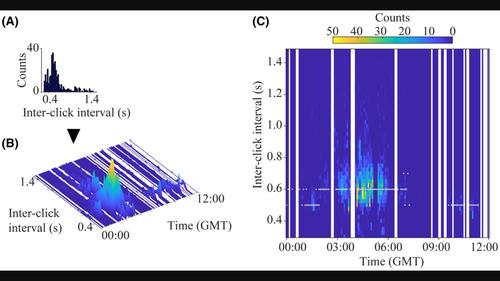当前位置:
X-MOL 学术
›
Remote Sens. Ecol. Conserv.
›
论文详情
Our official English website, www.x-mol.net, welcomes your feedback! (Note: you will need to create a separate account there.)
Echolocation repetition rate as a proxy to monitor population structure and dynamics of sperm whales
Remote Sensing in Ecology and Conservation ( IF 5.5 ) Pub Date : 2022-06-08 , DOI: 10.1002/rse2.278 Alba Solsona-Berga, Natalie Posdaljian, John A. Hildebrand, Simone Baumann-Pickering
Remote Sensing in Ecology and Conservation ( IF 5.5 ) Pub Date : 2022-06-08 , DOI: 10.1002/rse2.278 Alba Solsona-Berga, Natalie Posdaljian, John A. Hildebrand, Simone Baumann-Pickering

|
Characterizing population structure and dynamics is critical for the conservation of endangered species. Monitoring sperm whales Physeter macrocephalus is especially difficult because it requires monitoring different latitudes to capture the dynamics of most populations. Since their remarkable sexual dimorphism in body size is reflected in their sounds, passive acoustic monitoring presents an opportunity to capture contiguous patterns in time, space, and over large scales. We show that the echolocation repetition rate (measured as inter-click interval, ICI) as a proxy for body length is a suitable approach for large-scale acoustic monitoring. Body length has previously been estimated from the time interval between pulses (IPI) within sperm whale echolocation clicks. These estimates can only be achieved when whales are oriented toward the recorder or directly facing away, resulting in sparse data. A representative subsample of data demonstrated that ICI and IPI are linearly correlated, allowing conversion of ICI distributions into likely body length categories. This approach was applied to three monitoring sites in the Gulf of Mexico (2010–2017), where sperm whale population structure and male movements were poorly understood. We identified three classes: large animals between 12–15 m (ICI between 0.72 and 1 sec), presumed to correspond to adult males, and small animals below 12 m (ICI between 0.44 and 0.64 sec) likely pertaining to social groups (mixed groups with adult females and their offspring), and the third class with mid-sized animals (ICI between 0.64 and 0.83 sec) believed to contain adult females or sub-adult males. Our results revealed spatial and seasonal variability of the population structure including possible male presence throughout the year and migratory patterns of the population. This approach provides a means to efficiently characterize the putative population structure of sperm whales to understand the population's geographical dynamics and population status, which is relevant under rapidly changing habitat conditions.
中文翻译:

回声定位重复率作为监测抹香鲸种群结构和动态的代理
表征种群结构和动态对于保护濒危物种至关重要。监测抹香鲸Physeter macrocephalus特别困难,因为它需要监测不同的纬度以捕捉大多数种群的动态。由于它们在体型上显着的性别二态性反映在它们的声音中,被动声学监测提供了一个机会来捕捉时间、空间和大尺度上的连续模式。我们表明,回声定位重复率(测量为点击间隔,ICI)作为身体长度的代表是一种适合大规模声学监测的方法。体长以前是根据抹香鲸回声定位点击中脉冲之间的时间间隔 (IPI) 估算的。这些估计只有在鲸鱼朝向记录器或直接背对着它们时才能实现,从而导致数据稀疏。有代表性的数据子样本表明 ICI 和 IPI 是线性相关的,允许将 ICI 分布转换为可能的体长类别。这种方法应用于墨西哥湾(2010-2017 年)的三个监测点,那里的抹香鲸种群结构和雄性活动知之甚少。我们确定了三类:12-15 m 之间的大型动物(ICI 在 0.72 和 1 秒之间),假定对应于成年雄性,以及 12 m 以下的小型动物(ICI 在 0.44 和 0.64 秒之间)可能属于社会群体(混合群体)与成年雌性和它们的后代)和第三类中型动物(ICI 在 0.64 和 0.83 秒之间)被认为包含成年雌性或亚成年雄性。我们的结果揭示了人口结构的空间和季节变化,包括全年可能存在的男性和人口的迁徙模式。
更新日期:2022-06-08
中文翻译:

回声定位重复率作为监测抹香鲸种群结构和动态的代理
表征种群结构和动态对于保护濒危物种至关重要。监测抹香鲸Physeter macrocephalus特别困难,因为它需要监测不同的纬度以捕捉大多数种群的动态。由于它们在体型上显着的性别二态性反映在它们的声音中,被动声学监测提供了一个机会来捕捉时间、空间和大尺度上的连续模式。我们表明,回声定位重复率(测量为点击间隔,ICI)作为身体长度的代表是一种适合大规模声学监测的方法。体长以前是根据抹香鲸回声定位点击中脉冲之间的时间间隔 (IPI) 估算的。这些估计只有在鲸鱼朝向记录器或直接背对着它们时才能实现,从而导致数据稀疏。有代表性的数据子样本表明 ICI 和 IPI 是线性相关的,允许将 ICI 分布转换为可能的体长类别。这种方法应用于墨西哥湾(2010-2017 年)的三个监测点,那里的抹香鲸种群结构和雄性活动知之甚少。我们确定了三类:12-15 m 之间的大型动物(ICI 在 0.72 和 1 秒之间),假定对应于成年雄性,以及 12 m 以下的小型动物(ICI 在 0.44 和 0.64 秒之间)可能属于社会群体(混合群体)与成年雌性和它们的后代)和第三类中型动物(ICI 在 0.64 和 0.83 秒之间)被认为包含成年雌性或亚成年雄性。我们的结果揭示了人口结构的空间和季节变化,包括全年可能存在的男性和人口的迁徙模式。

























 京公网安备 11010802027423号
京公网安备 11010802027423号